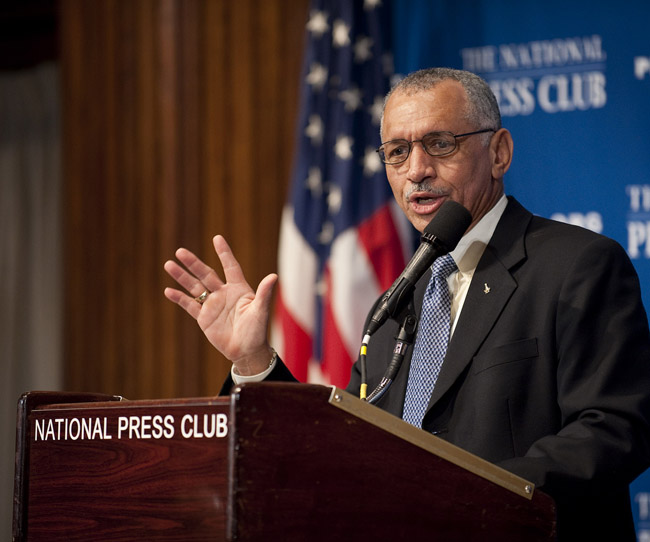NASA Awards $50 Million to Commercial Spaceship Builders

NASA on Tuesday unveiled awards totaling $50 million to support the commercial spaceflight efforts of five American companies, one day after announcing a new plan to use privately built spaceships to launch astronauts to space instead of government vehicles.
NASA chief Charles Bolden announced the winners of the space agency's commercial crew development competition to encourage progress in privately built spacecraft during a morning briefing at the National Press Club in Washington, D.C.
"Ladies and gentlemen, these are the faces of the new frontier. The vanguard," said Bolden. "We will certainly be adding to this group in the near future."
The competition's $50 million award came from NASA's stimulus money from the American Recovery and Reinvestment Act of 2009. The winning companies under the program include:
Sierra Nevada Corp.: At $20 million, Sierra Nevada in Centennial, Colo., is the top winner of the competition and received the funds to further develop Dream Chaser, a seven-person spacecraft designed to launch astronauts into space using an Atlas 5 rocket.
The Boeing Co.: Boeing, a major NASA contractor on the International Space Station and shuttle, will receive $18 million in competition funds to support the development of its own seven-person space capsule to launch astronauts using a medium-class rocket.
United Launch Alliance: A veteran of expendable rocket launches, the joint effort by Boeing and Lockheed Martin will receive $6.7 million to develop an emergency detection system to monitor the health of its Atlas 5 and Delta 4 rockets — unmanned expendable boosters that could be repurposed to launch manned spacecraft.
Get the Space.com Newsletter
Breaking space news, the latest updates on rocket launches, skywatching events and more!
Blue Origin: A normally secretive team established by Amazon.com founder Jeff Bezos, Blue Origin in Kent, Wash., has been quietly developing a vertical launch and landing spacecraft called New Shepard. The firm will receive $3.7 million to develop a novel launch escape system and build a crew-carrying module made of composite materials for structural tests.
Paragon Space Development Corp.: This Tucson, Ariz.-based company will receive $1.4 million to develop an environmental control and life support air vitalization system for use in space.
The five awards join two billion-dollar contracts already in place between NASA and private space industry to supply unmanned cargo shipments to the International Space Station.
Space Exploration Technologies (SpaceX) of California and Virginia-based Orbital Sciences Corp. have received contracts worth $3.5 billion in total to build and launch unmanned cargo ships to the station.
On Monday, President Barack Obama unveiled the 2011 budget request for NASA as part of overall budget for the country. The request included a $6 billion boost over five years to support commercial spaceflight development, but scrapped NASA's Constellation program to build new Orion spacecraft and Ares rockets aimed at returning astronauts to the moon.
Bolden said today's announcement tied directly into NASA's new plan to embrace commercial spaceflight more directly, but did not mean the United States was turning away from human spaceflight.
"We are not abandoning human spaceflight by any stretch of the imagination," Bolden said, adding that NASA hired a new class of astronauts last year.
The new plan, he added, is to develop new technologies and capabilities to sustain future expeditions to the moon, asteroids, Mars or elsewhere in the solar system. New rocket propulsion is one of those technologies.
"When I talk about game-changing propulsion, we're talking about going back to some stuff that NASA has on the shelf," Bolden said.
Lighter spacecraft, orbital fuel depots and faster ways to reach distant parts of the solar system are potential projects, he added.
White House science advisor John Holdren also emphasized that NASA's new direction will not back off of human spaceflight.
"It is not a retreat from U.S. leadership of human spaceflight as some are asserting," Holdren said. "But rather an exciting and promising path forward that invests in new ideas, new technologies and the complementary strength between NASA and the private sector in order to make human access both to low-Earth orbit and beyond to deep space faster, safer and more affordable than it could ever have been on the old path."
Join our Space Forums to keep talking space on the latest missions, night sky and more! And if you have a news tip, correction or comment, let us know at: community@space.com.

Tariq is the Editor-in-Chief of Space.com and joined the team in 2001, first as an intern and staff writer, and later as an editor. He covers human spaceflight, exploration and space science, as well as skywatching and entertainment. He became Space.com's Managing Editor in 2009 and Editor-in-Chief in 2019. Before joining Space.com, Tariq was a staff reporter for The Los Angeles Times covering education and city beats in La Habra, Fullerton and Huntington Beach. In October 2022, Tariq received the Harry Kolcum Award for excellence in space reporting from the National Space Club Florida Committee. He is also an Eagle Scout (yes, he has the Space Exploration merit badge) and went to Space Camp four times as a kid and a fifth time as an adult. He has journalism degrees from the University of Southern California and New York University. You can find Tariq at Space.com and as the co-host to the This Week In Space podcast with space historian Rod Pyle on the TWiT network. To see his latest project, you can follow Tariq on Twitter @tariqjmalik.









